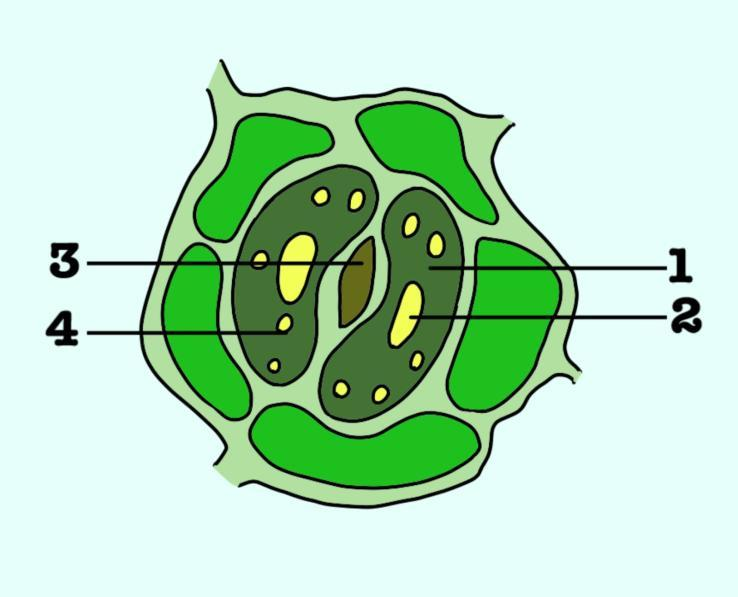
Write the name of the parts of the stomata given in the below diagram.

(A) I. Guard cell, II. Stoma, III. Starch granule, IV. Nucleus
(B) I. Cytoplasm, II. Nucleus, III. Stoma, IV. Chloroplast
(C) I. Guard cell, II. Starch, III. Nucleus, IV. Stoma
(D) I. Cytoplasm, II. Chloroplast, III. Stoma, IV. Nucleus

Answer
487.8k+ views
Hint: They provide for the exchange of gases between the outside air and the branched system of interconnecting air canals within the leaf. In response to the internal pressure of two sausage-shaped guard cells, it opens and closes that encompass it.
Complete answer
Stomata are little pores present inside the epidermis of leaves. They control the cycle of transpiration and gaseous exchange. The stomatal pore is encased between two bean-formed guard cells. The inward walls of guard cells are thick, while the external wall is slender. The guard cells are encircled by auxiliary cells. These are the specific epidermal cells present around the guard cells. The pores, the guard cells, and the auxiliary cells together establish the stomatal apparatus.
The guard cells work to manage extreme water loss, shutting on hot, dry, or blustery days and opening when conditions are greater for gas exchange. For most plants, sunrise triggers an abrupt expansion in the stomatal opening, arriving at the greatest close to early afternoon, which is trailed by decay on account of water loss. In plants that photosynthesize with the CAM carbon fixation pathway, like bromeliads and members of the Crassulaceae, stomata are opened in the dark to scale back water loss from evapotranspiration.
So the correct answer is ‘I. Cytoplasm, II. Nucleus, III. Stoma, IV. Chloroplast’.
Note:
Smaller stomatal openings can be utilized related to a delegate atom with a high carbon dioxide partiality, PEPcase (Phosphoenolpyruvate carboxylase). Recovering the results of carbon obsession from PEPCase is an energy-concentrated cycle, be that as it may. Subsequently, the PEPCase elective is best just where water is restricting yet the daylight is abundant, or where high temperatures increase the dissolvability of oxygen comparative with that of carbon dioxide, amplifying RuBisCo's oxygenation issue.
Complete answer
Stomata are little pores present inside the epidermis of leaves. They control the cycle of transpiration and gaseous exchange. The stomatal pore is encased between two bean-formed guard cells. The inward walls of guard cells are thick, while the external wall is slender. The guard cells are encircled by auxiliary cells. These are the specific epidermal cells present around the guard cells. The pores, the guard cells, and the auxiliary cells together establish the stomatal apparatus.
The guard cells work to manage extreme water loss, shutting on hot, dry, or blustery days and opening when conditions are greater for gas exchange. For most plants, sunrise triggers an abrupt expansion in the stomatal opening, arriving at the greatest close to early afternoon, which is trailed by decay on account of water loss. In plants that photosynthesize with the CAM carbon fixation pathway, like bromeliads and members of the Crassulaceae, stomata are opened in the dark to scale back water loss from evapotranspiration.
So the correct answer is ‘I. Cytoplasm, II. Nucleus, III. Stoma, IV. Chloroplast’.
Note:
Smaller stomatal openings can be utilized related to a delegate atom with a high carbon dioxide partiality, PEPcase (Phosphoenolpyruvate carboxylase). Recovering the results of carbon obsession from PEPCase is an energy-concentrated cycle, be that as it may. Subsequently, the PEPCase elective is best just where water is restricting yet the daylight is abundant, or where high temperatures increase the dissolvability of oxygen comparative with that of carbon dioxide, amplifying RuBisCo's oxygenation issue.
Recently Updated Pages
Master Class 12 Business Studies: Engaging Questions & Answers for Success

Master Class 12 Economics: Engaging Questions & Answers for Success

Master Class 12 English: Engaging Questions & Answers for Success

Master Class 12 Maths: Engaging Questions & Answers for Success

Master Class 12 Social Science: Engaging Questions & Answers for Success

Master Class 12 Chemistry: Engaging Questions & Answers for Success

Trending doubts
What is meant by exothermic and endothermic reactions class 11 chemistry CBSE

Which animal has three hearts class 11 biology CBSE

10 examples of friction in our daily life

One Metric ton is equal to kg A 10000 B 1000 C 100 class 11 physics CBSE

1 Quintal is equal to a 110 kg b 10 kg c 100kg d 1000 class 11 physics CBSE

Difference Between Prokaryotic Cells and Eukaryotic Cells




